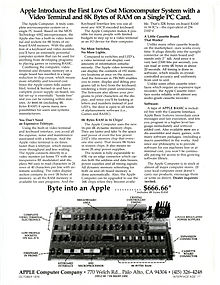Apple I
Production was discontinued on September 30, 1977, after the June 10, 1977 introduction of its successor, the Apple II, which Byte magazine referred to as part of the "1977 Trinity" of personal computing (along with the PET 2001 from Commodore Business Machines and the TRS-80 Model I from Tandy Corporation).[14] In 1974, while visiting famous phone phreak John Draper in California, Steve Wozniak watched him connect a modem to the ARPANET – the precursor to the internet – and use a teleprinter to play chess with someone from Boston, which inspired him to make a cheap terminal that used an inexpensive keyboard from Sears and a standard TV.[25] Wozniak intended to share schematics of the machine for free, but Jobs advised him to start a business together and sell bare printed circuit boards for the computer.[33][34] Terrell told Jobs that he would order 50 units of the Apple I and pay $500 each[d] on delivery, but only if they came fully assembled – he was not interested in buying bare printed circuit boards with no components.If you give me the parts on net 30-day terms I can build and deliver the computers in that time frame, collect my money from Terrell at the Byte Shop and pay you.Terrell was surprised to receive a batch of assembled circuit boards, as he had expected complete computers with a case, monitor and keyboard.[43] Jobs had managed to get the inventory into the nation's first four storefront microcomputer retailers: Byte Shop (Palo Alto, California), itty bitty machine company (Evanston, Illinois), Data Domain (Bloomington, Indiana), and Computer Mart (New York City).Two original Apple-1s have been analyzed by Professional Sports Authenticator in Los Angeles, concluding that the serial numbers had been hand-written by Steve Jobs.[50] The Apple I used a MOS Technologies 6502 microprocessor running at 1.022727 MHz, and its design was based largely on Wozniak's previous work centered around a Motorola 6800.A BASIC interpreter, originally written by Wozniak, was provided with the cassette interface that let users easily write programs and play simple games.This, combined with its single-board construction, made the Apple I an elegant and inexpensive machine for its day, though competitors such as the Sol-20 and Sphere 1 offered similar feature sets.[54] It was capable of displaying uppercase characters, numbers and basic punctuation and math symbols with a 5x8 pixel font:[55] A cassette interface was available in the form of an optional add-on for the Apple I's expansion slot.Other software tapes were supplied "at minimal cost"[52] including ported video games such as Hamurabi, Lunar Lander and Star Trek.




Apple OneApple 1 (disambiguation)Steve WozniakApple Computer CompanyMotherboardpersonal computerOperating systemsystem monitorMOS 6502Removable storageSignetics 2513Early hobbyistApple IIApple Inc.its first productworld's largest technology companySteve Jobsvideo display terminalcomposite videoSol-20Homebrew Computer ClubPalo Alto, CaliforniaMOS Technology 6502BASIC interpreterByte magazine1977 TrinityCommodore Business MachinesTRS-80 Model ITandy Corporationcomputer museumsJohn DraperCaliforniaARPANETinternetteleprinterBostonmicrocomputersAltair 8800Intel 8080Motorola 6800printed circuit boardsHP-65 scientific calculatorVolkswagen vanPaul TerrellMountain View, CaliforniaByte Shopnet 30-daynumber of the beastEvanston, IllinoisBloomington, IndianaLiza LoopMOS Technologies 6502cassette tapescomputer terminalcomposite monitorkeyboardtelevision setRF modulatorteletypewriterSphere 1character generatorshift register memorypixel fontphone connector portscassette deckInteger BASICportedHamurabiLunar LanderStar TrekApple IIeChristie'sPolytechnic University of TurinHenry Ford MuseumBonhamselectronics recycling centerSilicon ValleyReplica 1clonesSAM CoupéCommodore 64Computer museumHistory of computer scienceHistory of computingMcCusker, J. J.American Antiquarian SocietyForbesFreiberger, PaulSwaine, MichaelYouTubeWozniak, SteveMcGraw-HillAppleInsiderSmith, GinaW. W. Norton & CompanyHoboken, New JerseyJohn Wiley & SonsMeasuringWorthGross Domestic Product deflatorCBS NewsMilpitasCBC NewsAssociated PressMercury NewsWayback MachineComputerworldIsaacson, WalterSimon & SchusterComputersII PlusIIc PlusCompact MacintoshClassicClassic IIColor ClassicMacintosh IIMacintosh LCLC IIILC 500 seriesMacintosh TVMacintosh QuadraPowerBook100 series500 seriesPowerPCPower Macintosh